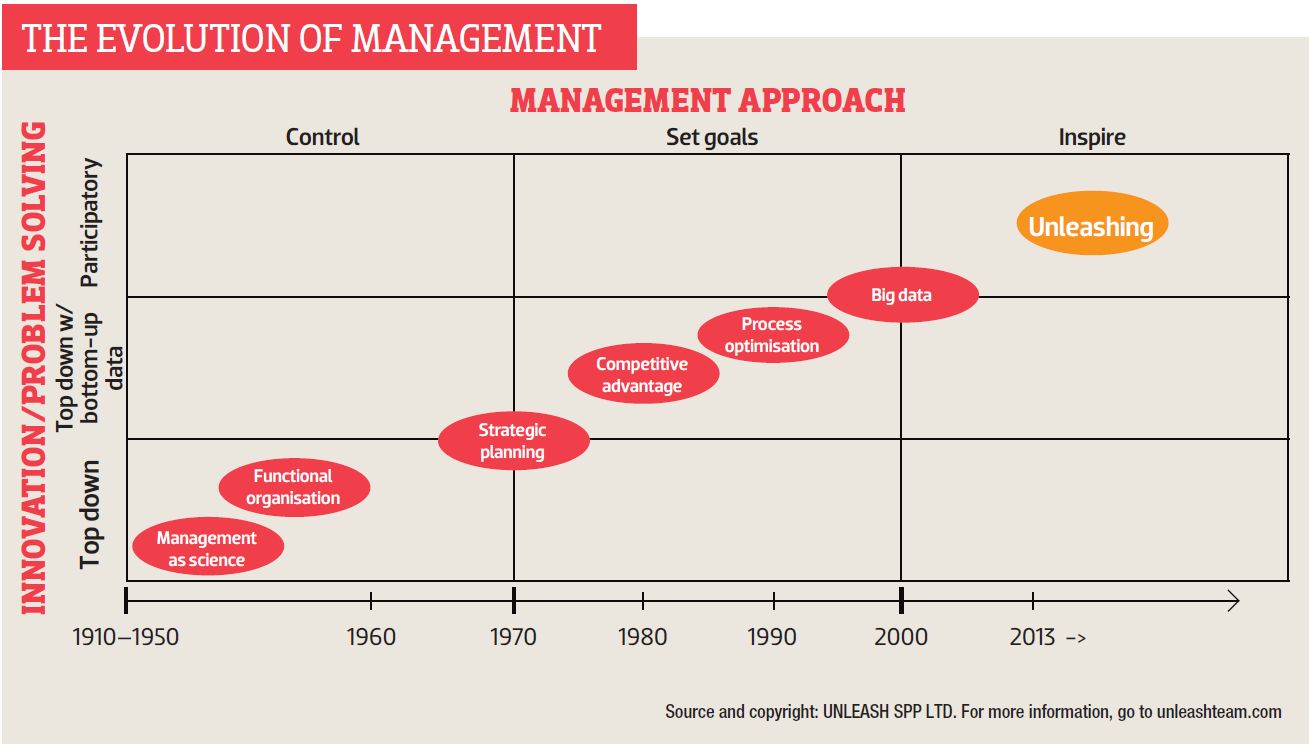Management is in need of a revolution. And not just one on glossy academic paper, but one that actually changes how organisations think and act. Despite the inspirational stories we read about companies like Zappos, Innocent Drinks and Google, the truth is that most of us are using outdated management practices and failing to get the most out of our people. Not convinced? Consider this:
- 65% of people are unhappy at work (Right Management, Manpower Group, 2012 online survey)
- Only 14% understand their company’s strategy (Smither, J.W., and London, M. (2009). Performance management: putting research into action)
- 75% are seeking jobs as we speak (Jobvite’s Social Job Seeker Survey, 2012)
Today’s leaders face increased complexity and ambiguity, and employees and customers alike are demanding engagement, transparency and responsibility. One billion people are now on Facebook, and 500 million tweets get sent every day. Customers don’t want to be sold to. They want to connect with brands and play a role in the development, sales and marketing of products.
If we ever thought we had ‘control’, it’s definitely gone now.
All of this presents a new challenge for how we think about and practise management and how we develop leaders that can excel in this brave new world.
But before we look at the future, let’s take a look in the rear-view mirror and see how we got to where we are today:
1910S–1940S: MANAGEMENT AS SCIENCE
‘Management as science’ was developed in the early 20th century and focused on increasing productivity and efficiency through standardisation, division of labour, centralisation and hierarchy. A very ‘top down’ management style with strict control over people and processes dominated across industries.
1950S–1960S: FUNCTIONAL ORGANISATIONS
Due to growing and more complex organisations, the 1950s and 1960s saw the emergence of functional organisations and the human resource movement. Managers began to understand the human factor in production and productivity, and tools such as goal setting, performance reviews and job descriptions were born.
1970S: STRATEGIC PLANNING
In the 1970s we changed our focus from measuring function to resource allocation and tools such as Strategic Planning (GE), Growth Share Matrix (BCG) and SWOT were used to formalise strategic planning processes. After several decades of ‘best practice’ and ‘one size fits all’ solutions, academics began developing contingency theories.
1980S: COMPETITIVE ADVANTAGE
As the business environment grew increasingly competitive and connected, and with a blooming management consultancy industry, competitive advantage became a priority for organisations in the 1980s. Tools such as Total Quality Management (TQM), Six Sigma and Lean were used to measure processes and improve productivity. Employees were more involved in collecting data, but decisions were still made at the top, and goals were used to manage people and maintain control.
1990S: PROCESS OPTIMISATION
Benchmarking and business process re-engineering became popular in the 1990s, and by the middle of the decade, 60% of Fortune 500 companies claimed to have plans for or had already initiated such projects. TQM, Six Sigma and Lean remained popular, and a more holistic, organisation-wide approach and strategy implementation took the stage, with tools such as Strategy Maps and Balanced Scorecards.
2000S: BIG DATA
Largely driven by the consulting industry under the banner of ‘Big Data’, organisations in the 2000s started to focus on using technology for growth and value creation. Meanwhile, oversaturation of existing market space led to concepts such as Blue Ocean Strategy and Value Innovation.
A WHOLE NEW LEVEL
After a century of trying to control people, processes and information, we have come to a point in organisational history where we need to recognise that what worked before just simply isn’t enough anymore.
Traditional management is fine if you want compliance, but if you want innovation and growth, you need to engage your people on a whole new level.
In our research, we looked specifically at the evolution of the management approach and the approach to innovation/problem solving, and at how these would develop in the future (see graph, ‘The evolution of management’):
1. Management approach: the style of top management, ranging from:
a. Control (ie your boss tells you what to do and how to do it); to
b. Set goals (ie your boss sets goals and expectations, but you have more freedom with regard to how you achieve them); to
c. Inspire (ie your boss gives you scope and freedom to innovate on both the what and the how)
2. Approach to innovation/problem solving: how leaders solve strategic problems and develop new products and services. This ranges from:
a. Top down (ie solutions are created and come from the top); to
b. Top down with bottom-up data (ie the rest of the organisation contributes information and experiences, but solutions are still created at the top); to
c. Participatory (ie solutions are created collaboratively, and throughout the organisational levels)
Organisations of the future are neither consensus driven nor top down. They aren’t dictatorships, nor are they anarchies. They’re not merely occupied with increasing shareholder value or making their people happy. Leaders of the future know that the two go together, and that having happy and productive workforces is not about team-building exercises or lucrative benefit packages but about creating a working environment that offers pur-pose, mastery, challenge and autonomy, which in turn creates more business value than the traditional approach.
 (Click on image to enlarge)
(Click on image to enlarge)
Recently, Steve Denning wrote about the management revolution that’s already happening at Forbes.com. In the article, he discusses organi-sations like Apple, Zara and Whole Foods that have successfully forged ahead despite the increasingly challenging environment: “None of these organi-zations has arrived at any final state or equilibrium: in each case, management practices continue to evolve. Nor are any of these organizations perfect, as they have to cope with a context that is filled with contradictions. Their virtue lies in the creative energy with which they are pioneering new ways of adding value”.
Steve makes some excellent points about the need to constantly reinvent ourselves, but I’m not sure if the revolution is already happening. In fact, I think it might be more of an evolution. And herein lies the problem. We need a revolution, not an evolution. We are armed with tons of research that supports a more holistic, human way of doing business. It is up to us to stop simply following best practice and translate our know-how into how we develop leaders and organisations that are more agile, innovative and purpose-driven… and, in doing so, breed the pioneers and market leaders of tomorrow.
 Therese S. Kinal is the CEO and co-founder of Unleash, a disruptive innovator in the management education and consulting industry. She is the co-author of Unleashing: The Future of Work, and she writes, runs workshops and works with clients on a range of management issues.
Therese S. Kinal is the CEO and co-founder of Unleash, a disruptive innovator in the management education and consulting industry. She is the co-author of Unleashing: The Future of Work, and she writes, runs workshops and works with clients on a range of management issues.



 Therese S. Kinal is the CEO and co-founder of Unleash, a disruptive innovator in the management education and consulting industry. She is the co-author of Unleashing: The Future of Work, and she writes, runs workshops and works with clients on a range of management issues.
Therese S. Kinal is the CEO and co-founder of Unleash, a disruptive innovator in the management education and consulting industry. She is the co-author of Unleashing: The Future of Work, and she writes, runs workshops and works with clients on a range of management issues.
